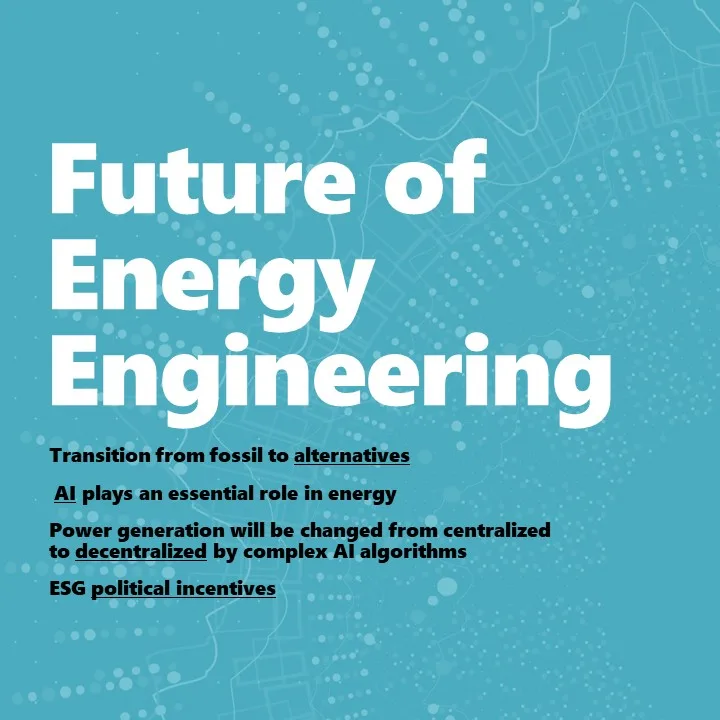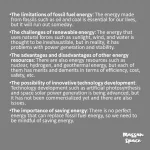Alternative Energies = Renewable Energies
These are just some examples of alternative energy sources that can be used instead of fossil fuels. The transition to renewable energy is critical to curbing the climate crisis and reducing our reliance on finite resources such as coal, oil, and natural gas.
Solar power:
Solar energy systems harness the power of the sun to generate electricity. They do not emit greenhouse gas or air pollution, making them one of the best potential solutions to the climate crisis.
Wind power:
Wind turbines convert the kinetic energy of wind into electricity. Like solar power, wind power is a clean and renewable source of energy.
Hydroelectric power:
Hydroelectric power plants use the energy of falling water to generate electricity. This is a renewable source of energy that does not emit greenhouse gases or air pollution.
Geothermal energy:
Geothermal power plants use heat from the Earth’s interior to generate electricity. This is a renewable source of energy that does not emit greenhouse gases or air pollution.
Tidal power:
Tidal power plants use the energy of ocean tides to generate electricity. This is a renewable source of energy that does not emit greenhouse gases or air pollution.
Biomass and biofuels:
Biomass and biofuels can be good sources of alternative energy, but only if they are produced responsibly. These sources of energy are derived from organic materials such as wood, crops, and waste.
Artificial Intelligence (AI)
Optimizing Energy Grids:
AI can manage energy flows between homes, businesses, storage batteries, renewable energy sources, microgrids, and the power grid itself. This reduces energy waste while increasing consumer engagement with energy consumption.
Forecasting and Managing Renewable Energy:
AI and machine learning can help energy companies predict when renewable energy will be available and manage energy grids accordingly.
Power Management Maintenance and Control of Renewable Energy Systems:
Techniques such as Artificial Neural Networks (ANN), Adaptive Neuro-Fuzzy Inference Systems (ANFIS), and Genetic algorithms (GA) are used in power management maintenance and control of renewable energy systems.
Combination of AI and IoT:
The combination of AI and the Internet of Things (IoT) technologies is powerful since the IoT and sensors can harness large volumes of data, and AI can learn patterns in the data to automate tasks for various business benefits.
Applications in Power Electronics:
AI applications for power electronic systems include optimization, classification, regression, and data structure exploration.
Remember that the application of AI in energy engineering requires a good understanding of both the domain (energy engineering) and AI techniques. It’s also important to keep up with the latest research and developments in this field.
Decentralization
Decentralized energy generation involves using a variety of smaller power generation plants and storage units that can be grid-connected to provide power supply. The energy that is generated off the main grid can include micro-renewables, heating, and cooling1. Here are some ideas for decentralized energy generation. The key is to use a variety of technologies that are appropriate for the local context and to integrate them into the existing energy infrastructure.
Micro-renewables:
Micro-renewables such as solar panels and small wind turbines can be installed on homes and businesses to generate electricity locally. This reduces reliance on the main grid and can help to lower energy costs.
Combined heat and power:
Combined heat and power (CHP) systems generate electricity and heat simultaneously, making them highly efficient. CHP systems can be installed in buildings or industrial parks to provide local power and heat.
District heating and cooling:
District heating and cooling systems distribute heat or cold air from a central plant to multiple buildings in a community. This can be more efficient than individual heating or cooling systems in each building.
Energy from waste:
Energy from waste plants convert waste into electricity, heat, or fuel. This reduces the amount of waste sent to landfills and provides a local source of energy.
Geothermal energy:
Geothermal power plants use heat from the Earth’s interior to generate electricity. This is a renewable source of energy that does not emit greenhouse gases or air pollution.
Political Incentives
Political incentives can be a powerful tool for promoting energy innovation. Here are some ways to use them effectively:
Fiscal Incentives for Innovation:
Governments can provide fiscal incentives to companies investing in the research and development of more efficient solutions that would eventually be brought to market1. This “technology-push” option might bear fruit only a few years down the line, once the new technology had been developed and commercialized.
Subsidies for Adoption:
Governments can also subsidize households willing to install renewable energy systems already available on the market and guarantee an advantageous price for the sale of excess electricity back to the grid. This “demand-pull” mechanism obviously favors existing technology, already on the market, and it does not necessarily incentivize the development of radical innovation that would become available only after a few years.
Stimulate the Economy:
As a third option, governments could decide to stimulate the economy overall by, for example, lowering taxes based on the hypothesis that a richer country is more likely to adopt renewable energy solutions, especially if they are more expensive than fossil fuel technologies.
Public Investment:
The COP26 United Nations Climate Change Conference resulted in the commitment of billions of dollars to climate finance, to advance environmental sustainability and phase out the use of coal1. The COP26 Energy Transition Council stated the aim of doubling the rate of investment in clean power by 2030.
Sectoral Reforms:
The sectoral reforms will likely require broad coalitions of support, while the complementary technologies (e.g., utility-scale battery storage) may require engagement at the top of another experience curve2.
Remember that political incentives should be used as part of a comprehensive strategy that includes technological innovation, infrastructure development, and public education about renewable energy.



コメント
Very interesting details you have observed, thank you for
putting up.Blog monry